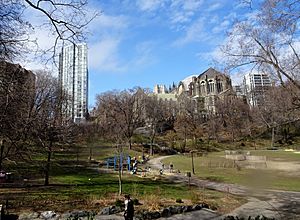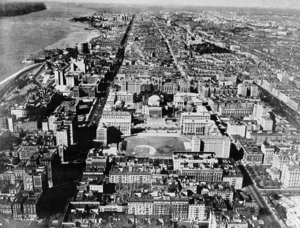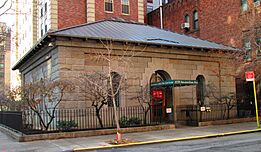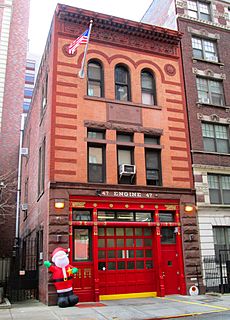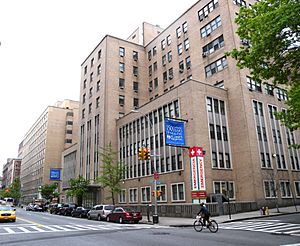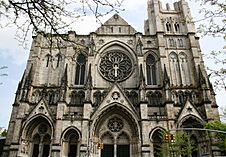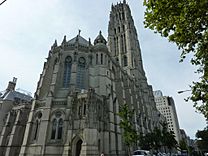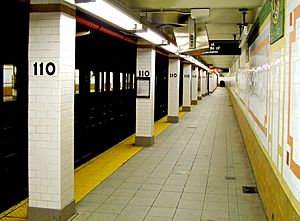Morningside Heights facts for kids
Quick facts for kids
Morningside Heights
|
|
|---|---|
|
Neighborhood of Manhattan
|
|
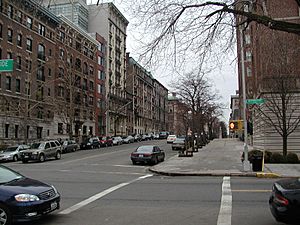
Residential buildings on West 116th Street opposite Columbia University
|
|
| Country | United States |
| State | New York |
| City | New York City |
| Borough | Manhattan |
| Community District | Manhattan 9 |
| Area | |
| • Total | 0.472 sq mi (1.22 km2) |
| Population
(2016)
|
|
| • Total | 31,884 |
| • Density | 67,550/sq mi (26,082/km2) |
| Ethnicity | |
| • White | 46.0% |
| • Hispanic | 23.5 |
| • Black | 13.6 |
| • Asian | 13.3 |
| • Others | 3.6 |
| Economics | |
| • Median income | $81,890 |
| Time zone | UTC−5 (Eastern) |
| • Summer (DST) | UTC−4 (EDT) |
| ZIP Codes |
10025, 10027
|
| Area code | 212, 332, 646, and 917 |
Morningside Heights is a cool neighborhood in Upper Manhattan, New York City. It's on the west side of the island. Imagine a rectangle: it's bordered by Morningside Drive to the east, 125th Street to the north, 110th Street to the south, and Riverside Drive to the west.
This area is like a high plateau, sitting between two big parks: Morningside Park and Riverside Park. For a long time, it was hard to get to. It only started to grow in the late 1800s when big schools and cultural places decided to build there. By the early 1900s, with new public transport like the subway, Morningside Heights became a busy place with lots of homes.
Today, a huge part of Morningside Heights is home to Columbia University, a famous private university. But it's not just Columbia! Many other schools are here too, like Teachers College, Barnard College, and the Manhattan School of Music. You'll also find beautiful churches like the Cathedral of St. John the Divine and Riverside Church, plus historic spots like Grant's Tomb.
Morningside Heights is part of Manhattan Community District 9. The local police are from the 26th Precinct of the New York City Police Department.
Contents
- History of Morningside Heights
- People and Population
- Buildings and Landscape
- Fire Safety
- Health in the Neighborhood
- Education in Morningside Heights
- Places of Worship
- Getting Around
- Famous People from Morningside Heights
- See also
History of Morningside Heights
Early Days and First Settlers
Long ago, Manhattan was home to the Lenape Native Americans. They called the nearby area "Muscota," which meant "place of rushes." Traveling around New York City was mostly done by water back then, as there weren't many roads.
In the early 1600s, Dutch settlers arrived and named the area "Vredendal," meaning "peaceful dale." Later, the British took over. A main road, Bloomingdale Road (now Broadway), was extended north, making it easier to reach this area.
On September 16, 1776, a big battle called the Battle of Harlem Heights happened here during the American Revolutionary War. A special plaque at 117th Street and Broadway remembers this important fight.
Growing the Neighborhood in the 1800s
For about 50 years, Morningside Heights didn't have many buildings. There were mainly two large places: the Bloomingdale Insane Asylum and the Leake and Watts Orphan Asylum. The Croton Aqueduct, which brought water to the city, also ran through the area.
In the late 1800s, things started to change. Two big parks were planned: Riverside Park along the Hudson River and Morningside Park to the east. Famous landscape designers Frederick Law Olmsted and Calvert Vaux helped create these parks. Morningside Park was finished in 1895.
Even with these improvements, building homes was slow until the 1890s. The elevated train line, which opened in 1879, didn't have easy stops in Morningside Heights because of the steep hills. This meant other areas grew faster.
The "Academic Acropolis" Takes Shape (1890s-1930s)
In the late 1880s, people wanted the asylums to move so the area could develop. The Bloomingdale Asylum moved in 1888, and Leake and Watts followed in 1891. Their land was bought by Columbia University and the Episcopal Diocese of New York, which wanted to build the Cathedral of St. John the Divine.
Soon, many other schools and hospitals moved in, including Barnard College, Teachers College, and St. Luke's Hospital. This led to the area being called an "Academic Acropolis" because of all the important institutions.
New Name and First Homes
In the 1890s, people started calling the area "Morningside Heights" after Morningside Park. Before that, it had a few different names.
Developers began building the first homes, mostly row houses, around 1892. These early homes looked different from older ones in nearby areas. Later, the first apartment buildings, called tenements, were also built.
Growth of Schools and Churches
The Cathedral of St. John the Divine started construction, though it took a long time to build. Its presence encouraged other institutions to move nearby.
Columbia University was a huge part of the neighborhood's growth. Its president, Seth Low, hired architects to design a new campus. The Low Memorial Library was built between 1895 and 1897, and classes started in 1897. Many more buildings, like dorms and chapels, were added soon after.
Barnard College and Teachers College also grew quickly. Other important schools like Union Theological Seminary, the Manhattan School of Music, and the Jewish Theological Seminary of America also built their campuses here. Riverside Church was completed in 1930.
Apartment Buildings and the Subway
In the early 1900s, there weren't many homes yet. But when the New York City Subway opened in 1904, with stations at 110th, 116th, and 125th Streets, it changed everything. People could now easily travel to other parts of the city.
Developers quickly built many large apartment buildings for middle-class families. These new buildings had modern features like electric lights and fancy bathrooms. Morningside Heights became known for its nice apartment homes. By the 1920s, the neighborhood was fully developed, with homes and shops. Most residents were white and middle-class, often working as professionals.
Mid- and Late 20th Century Changes
Over time, the neighborhood's population started to change. More middle-class families moved in who weren't connected to the schools. During the Great Depression, many apartments were divided into smaller units, and some became single room occupancy (SRO) hotels. After World War II, many wealthier residents moved away, and the area saw some decline.
New Housing and Development
In 1947, fourteen big institutions in the neighborhood formed "Morningside Heights Inc." This group wanted to build new housing and improve the area. Their first project was Morningside Gardens, a large apartment complex for middle-income families, finished in 1957. It was designed to be a place where people of different backgrounds could live together.
Another big project was Grant Houses, a public housing development completed in 1956. These new buildings helped redefine the northern part of Morningside Heights.
Schools and Tensions
More institutions moved to Morningside Heights in the late 1950s and early 1960s, like the Interchurch Center and Bank Street College of Education. Columbia University helped with some of these moves, wanting to make the area a good place for its staff to raise families.
However, as the schools expanded, they bought many buildings, sometimes leading to protests from residents. People worried about being forced out of their homes. A big protest happened in 1968 when Columbia University planned to build a gym in Morningside Park, which would have created separate entrances for different groups. The university stopped the plan the next year.
Improvements and Growth (1970s-1990s)
In the 1970s, safety became a concern in the city. Columbia University continued to grow and became the biggest landlord in Morningside Heights. By the 1980s, Broadway, the main street, started to get new restaurants and shops, making the area feel safer and more fashionable. Columbia helped with these improvements to make the neighborhood more appealing.
By the late 1990s, Columbia owned most of the apartment buildings in the area. Morningside Park also became safer after renovations. Even with new developments, the neighborhood kept some of its original feel. Housing prices started to go up quickly in the late 1990s.
Morningside Heights in the 21st Century
In the late 1990s, some businesses tried to rename parts of Morningside Heights and southern Harlem as "SoHa" (for "South Harlem"). This name became very controversial, as many residents felt it was an attempt to change the neighborhood's identity and attract new, wealthier residents.
Today, new buildings are still being built among the older institutions. For example, new apartments have been added near the Cathedral of St. John the Divine. In 2017, a part of Morningside Heights was made a Historic District, which helps protect its historic buildings.
People and Population
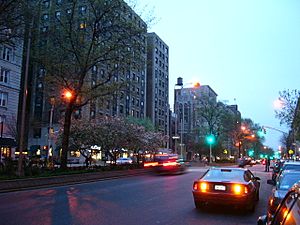
In 2010, Morningside Heights had about 55,929 people living there. The neighborhood is a mix of different groups: about 46% white, 23.5% Hispanic, 13.6% Black, and 13.3% Asian.
The average life expectancy in this area is about 81.4 years, which is similar to the rest of New York City. Most residents are young adults and middle-aged people.
In 2017, the average household income in Morningside Heights was about $81,890. About 24% of people in the larger Community District 9 live in poverty, which is higher than the average for Manhattan.
Buildings and Landscape
Morningside Heights is in Upper Manhattan. It's mostly zoned for tall apartment buildings, but you'll also find shops on Broadway and Amsterdam Avenue. A lot of the neighborhood is taken up by the buildings of its many schools and religious institutions.
Homes and Apartments
The homes in Morningside Heights are mostly apartment buildings, many from the early 1900s. Some of these old apartments were very large, with five to seven bedrooms. Two unique apartment buildings are The Colosseum and The Paterno on Riverside Drive, known for their curved shapes.
In the northern part of the neighborhood, you'll find two large housing complexes: Grant Houses, which are public housing buildings, and Morningside Gardens, a co-op apartment complex.
Important Buildings and Landmarks
Many buildings in Morningside Heights are special landmarks. The Cathedral of St. John the Divine and its surrounding buildings are city landmarks. Riverside Church and the Church of Notre Dame are also important landmarks.
Grant's Tomb, the resting place of U.S. president Ulysses S. Grant and his wife, is a national memorial and a city landmark. The old St. Luke's Hospital buildings (now Mount Sinai Morningside) are also recognized as landmarks.
On the Columbia University campus, Low Memorial Library is a National Historic Landmark. Other important buildings include Philosophy Hall, where FM radio was invented, and Pupin Hall, where early experiments on splitting uranium atoms happened. The St. Paul's Chapel is also a city landmark.
You can still see parts of the old Croton Aqueduct system, which brought water to the city. The gatehouse at 113th Street and the one at 119th Street are city landmarks.
Morningside Heights Historic District
In 2017, the New York City Landmarks Preservation Commission created the Morningside Heights Historic District. This means that many buildings in this area are protected because of their history and architecture. The district includes homes and school buildings on several streets.
Famous Spots

Tom's Restaurant, on Broadway at 112th Street, is famous because it was featured in the song "Tom's Diner" and its outside was used in the TV show Seinfeld.
The West End Bar was a popular meeting spot for writers and student activists in the past. The Hungarian Pastry Shop is also a well-known place for students and writers from Columbia University.
Natural Landscape
Morningside Heights sits on a high plateau. On its east side is Morningside Park, which was built because of a steep cliff that made it hard to build streets. This cliff was formed by natural earth movements. To the west is Riverside Park, along the Hudson River.
To the north, the plateau slopes down into the 125th Street valley. There's even a rock outcropping called Rat Rock on West 114th Street!
Fire Safety
Morningside Heights is protected by two New York City Fire Department (FDNY) stations. Engine Company 47 is located on West 113th Street. Its building, built in 1891, is a New York City landmark. Another fire station, Engine Company 37/Ladder Company 40, is nearby on West 125th Street.
Health in the Neighborhood
The air quality in Morningside Heights is generally good. About 17% of residents are smokers, which is a bit higher than the city average. About 21% of residents are obese, and 29% have high blood pressure.
Most residents (88%) eat fruits and vegetables daily. In 2018, 83% of residents said their health was "good" or "excellent."
The main hospital in Morningside Heights is Mount Sinai Morningside. Other hospitals like NYC Health + Hospitals/Harlem and Mount Sinai Hospital are also close by.
Education in Morningside Heights
The people in Morningside Heights generally have a high level of education. Many adults (49%) have a college degree or higher.
Local Schools
The New York City Department of Education runs several public schools in Morningside Heights:
- Columbia Secondary School (grades 6–12)
- PS 36 Margaret Douglas (grades PK-5)
- PS 125 Ralph Bunche (grades PK-5)
- PS 180 Hugo Newman (grades PK-8)
There are also private schools like Bank Street School for Children, St. Hilda's & St. Hugh's School, the Cathedral School of St. John the Divine, and the School at Columbia University.
Higher Education Hub
The area is often called an Academic Acropolis because it has so many colleges and universities.
A large part of the neighborhood is the campus of Columbia University, a famous private research university. Its main campus is between Broadway and Amsterdam Avenue, from 116th to 120th Streets.
Other important schools here include:
- Barnard College: A private women's college.
- Teachers College: Affiliated with Columbia University.
- Union Theological Seminary.
- Manhattan School of Music: A music school.
- Jewish Theological Seminary of America.
- Bank Street College of Education.
- International House: A dorm for students from nearby schools.
NASA's Goddard Institute for Space Studies is also located here, in a building owned by Columbia University.
Libraries for Learning
The New York Public Library (NYPL) has two branches in Morningside Heights:
- The Morningside Heights branch at 2900 Broadway.
- The George Bruce branch at 518 West 125th Street.
Places of Worship
Morningside Heights has many religious buildings. The Cathedral of St. John the Divine on Amsterdam Avenue is one of the largest churches in the world. Riverside Church on Riverside Drive is another very famous church.
Other churches include the Church of Notre Dame and Corpus Christi Church, both Catholic churches. There are also Presbyterian and Unitarian churches, and the city's oldest Korean church. The Interchurch Center is an office building for religious groups.
Getting Around
You can get around Morningside Heights using the New York City Subway. There are stations at 110th Street and 116th Street on the IRT Broadway–Seventh Avenue Line (served by the 1 train trains). These stations opened in 1904 and are city landmarks. The subway line also goes over the 125th Street valley on a viaduct, which is also a landmark.
New York City Bus routes like the M4, M5, M11, M60 SBS, M104 also run through the neighborhood.
Famous People from Morningside Heights
Many well-known people have lived in Morningside Heights:
- Fiona Apple, singer-songwriter.
- George Carlin, comedian, grew up here. The block of 121st Street where he lived was named after him.
- Carrie Chapman Catt, a leader in the women's right to vote movement.
- F. Scott Fitzgerald, famous novelist who wrote This Side of Paradise while living here.
- George Gershwin, composer, started writing his famous Rhapsody in Blue here.
- Allen Ginsberg, poet.
- Thurgood Marshall, the first African-American Supreme Court justice.
See also
 In Spanish: Morningside Heights (Manhattan) para niños
In Spanish: Morningside Heights (Manhattan) para niños



